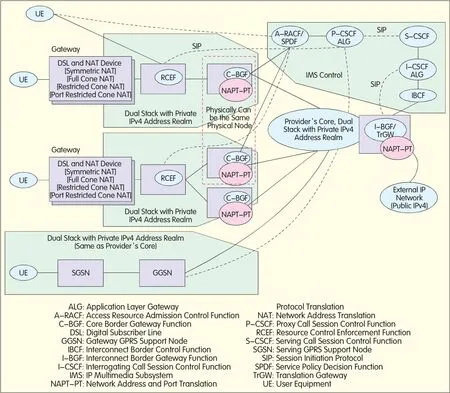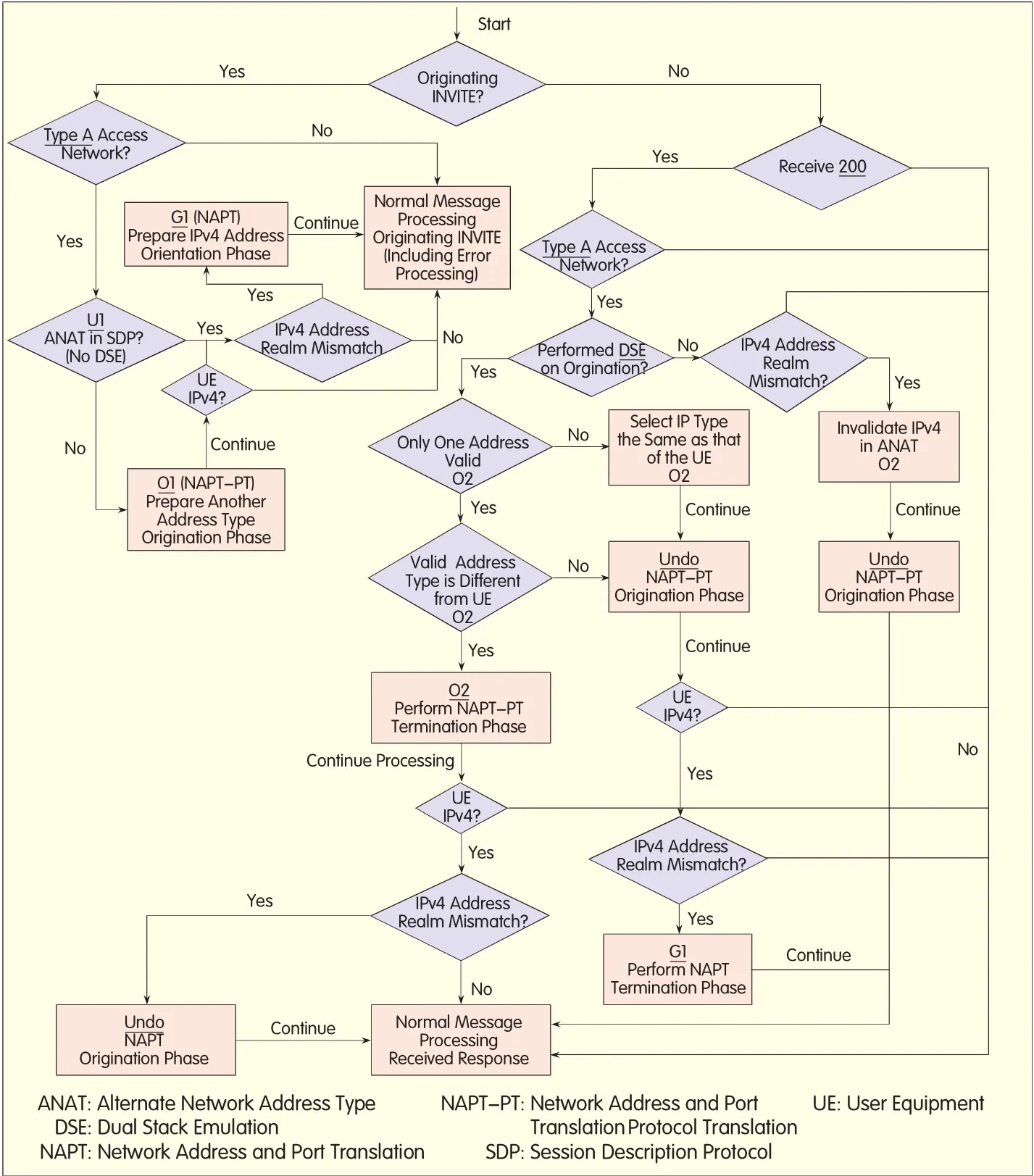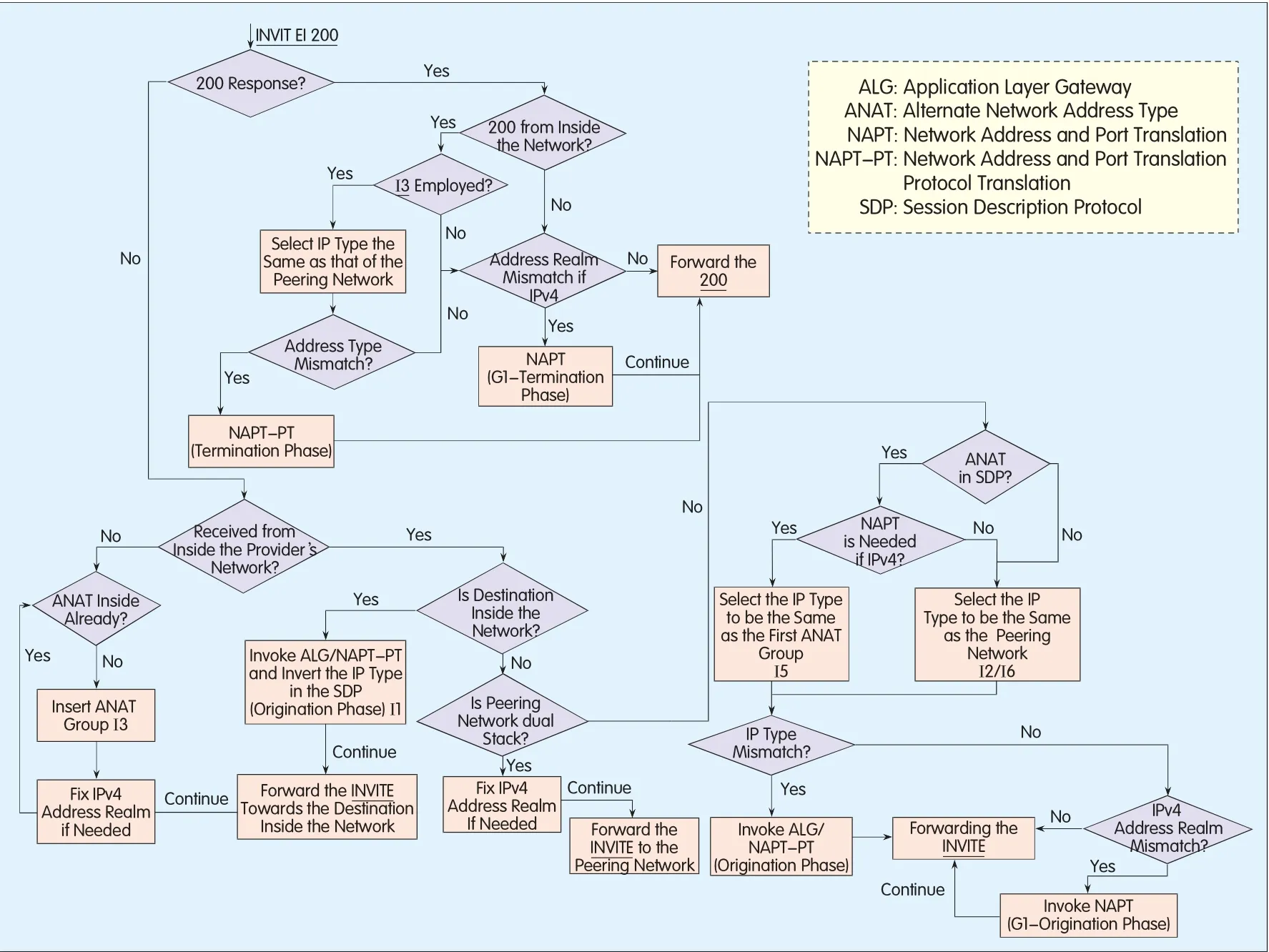IPv4 and IPv6 Migration in IMS Environment
Li Mo
(Global Marketing and Research Center, ZTE USA, 2425 North Central Expressway, Suite 323,Richardson, TX 75080, US)
Abstract:The lP Multimedia Subsystem(lMS)framework was envisioned to be operating on an lPv6 network.However,when the fixed network started to use lMS framework in the Next Generation Network(NGN)architecture,the issue of lPv4 and lPv6 interworking becomes more pronounced due to the widespread usage of the lPv4 network.The overall objective of the solution proposed in this article is to minimize the invocation of Network Address and Port Translation Protocol Translation(NAPT-PT)or Network Address and Port Translation(NAPT)inside the provider's network.The solution,outlined by the processing rules contained in this article,will limit the NAPT-PT operation at most once inside the provider's network under all the situations for the media path.This solution will also introduce the minimum required NAPT operations.
1 Introduction
In the original lPMultimedia Subsystem(lMS)specification[1]given by 3GPP,the lMSframework was envisioned to be operating on an lPv6 network.When the fixed network started to use lMSframework in the Next Generation Network(NGN)architecture[2-3],the issue of lPv4 and lPv6 interworking becomes more pronounced due to the widespread usage of the lPv4 network.
The central issue of lPv4 and lPv6 interworking is avoiding unnecessary Network Address and Port Translation Protocol Translation(NAPT-PT)operations inside the network.The major drawbacks of such operation are well understood and are listed as follows:
●Bottleneck location for media flows;
●Single point of failure at the NAPT-PTlocation;
●Breaks signaling protocols without Application Layer Gateway(ALG).
ln discussing the lPv4 and lPv6 interworking,there is a need to differentiate mobile terminals and fixed terminals.For mobile terminals,due to the restriction of Packet Data Protocol(PDP)type[4],a mobile terminalcan only operate in lPv4 or lPv6 mode only.For fixed terminals,it would be relative easy to operate in both modes.
Both the signaling pat hand media path will have lPv4 and lPv6 interworking issues.ln this paper,the networking environment and architectural components are articulated in Section 2.ln Section 3,the objectives of lPv4 and lPv6 interworking and the processing rules in various architecturalcomponents are given.Section 4 willperform extended scenario analysis to ensure that the operation rules given in Section 3 indeed satisfy the objectives outlined.
2 Networking Environment

▲Figure 1. Reference configuration.
Figure 1 outlines the networking environment which will be used as the base of the discussion.
ln this network environment, the User Equipment (UE) can be both mobile and fixed. The mobile UEis assumed to be connected to a Universal Mobile Telecommunication System(UMTS)network,characterized by Serving GPRS Supporting Nodes(SGSNs)and Gateway GPRSSupporting Nodes(GGSNs).The mobile access network,which consists of GGSN and SGSN,is assumed dualstack(i.e.having both lPv4 and lPv6 capabilities).Furthermore,the mobile access network is not capable of performing NAPT-PToperations.lf lPv4 is used,the lPv4 address realm will be the same as that of the provider's core network,which is further assumed to be private(Note,it would be much simpler if it is public).
The fixed UEis connected to the service provider's network via a gateway,which is performing Network Address Translation(NAT)operation for lPv4 addresses to alleviate the lPv4 address space issues.As far as the network is concerned,the first entry point will be Resource Control Enforcement Function[5](RCEF).The border control for the fixed network is located in Core Border Gateway Function(C-BGF)and it can perform the NAPT-PToperation.The fixed access network is assumed to be dual stack and,if lPv4 address is used,it is assumed to be private and every access network can have its specific,independent addressing plan.The NAPT-PToperation in the C-BGFis controlled by Access Resource Admission Control Function(A-RACF)and Proxy Call Control Function(P-CSCF)in the control plane.
The provider's core network connects both the mobile and fixed access network.The provider's core network is also assumed to be dual stack with lPv4 operating in its private addressing realm.The provider's core network is connected to the public network via lnterconnect Border Gateway Function(l-BGF).l-BGFis capable of performing NAPT-PToperations,under the discretion of lnterrogating Call Session Control Function(l-CSCF)or lnterconnect Border Control Function(lBCF)in the control plane.
3 Objectives
The overall objective is to minimize the invocation of NAPT-PTor NAPTinside the provider's network.The proposed solution,outlined by the processing rules contained in this document,will limit the NAPT-PToperation at most once inside the provider's network under all the situations for the media path.
This solution will also introduce the minimum required NAPToperations.lf there is a required NAPToperation along the media path for lPv4 address realm mismatches,there will be no NAPT-PT operation for protocolconversion purpose only.
The provider's network is bordered by the lBGF,GGSN,and C-BGFat the transport and media layer.The overall,generic objectives can be further articulated into the following items,with consideration of minimum NAPT-PT/NAPToperation and also to minimize callprocessing requirements:
(1)The solution will ensure that NAPT-PTwill only be invoked once inside a single provider's network for the media path.
(2)NAPToperations will be combined with the NAPT-PToperations whenever it is possible.
(3)The solution will cause detour of the media traffic due to NAPT-PTusage only when there is no NAPT-PTcapable network elements along the normal media path.
(4)The solution will be independent of network lPv4 addressing plans in the access network and the provider's core network,while the lPv6 address is assumed to be global.
(5)The solution willavoid unnecessary invocation of service logic in Serving Call Session Control Function(S-CSCF)because of recursion of the signaling path(e.g.using 305 Session lnitiation Protocol(SlP)response from downstream nodes of S-CSCF).
4 NAPT-PT Location Determination
ln this section,the NAPT-PT/NAPT related algorithms for determining where the operation is to be performed,if it will be performed at all.The NAPT-PT/NAPT processing algorithms will be imposed upon P-CSCF,Media Gateway Control Function(MGCF),Media Resource Function(MRF),Application Servers(AS),and the lBCFin a coordinated fashion.
4.1 Network Assumptions
lt is assumed that the provider's access address realm,the provider's core address realm,and the public lnternet are all distinct lPaddress realms for lPv4.lf some of the abovementioned lPrealms are shared,the processing rules discussed in next section can also be applied because the lPv4 address realms are only imposing NAPT requirements.
ln terms of NAPT-PToperations,the merging of those address realms willnot affect the NAPT-PTlocations in this solution while the current work assumption presents the most challenging situation.There will be no change of the processing rules due to the difference in network addressing plans for lPv4.
lt is assumed that all equipment along the signaling path is dual stack network elements supporting RFC 4092 and RFC 4091,i.e.Alternate Network Address Type(ANAT)functions.The network elements performing NAPTfunctions can also perform NAPT-PTfunctions.
lt is further assumed that some border elements at the network edge are not capable of NAPT-PT/NAPToperation.Hence the network,on the access side,can be classified into two types:
(1)Type A:This type of access network is capable of performing NAPT-PTand NAPToperations(e.g.C-BGF).
(2)Type B:This type of access network is not capable of performing NAPT-PTand NAPToperations(e.g.GGSN)
The access network type designation will be used for presentation purposes only.Any decision regarding the type of the access network would be local(e.g.the P-CSCFknows if it has a corresponding SPDFand C-BGFin order to perform the NAPT-PTtask).
For the purpose of the presentation clarity,the border element C-BGFis assumed to be NAPT-PTand NAPT capable while the GGSN does not have NAPT-PTand NAPTfunctionalities.
ln general,P-CSCFwith corresponding SPDFand C-BGFare considered as Type A,and allthe other types of network are considered to be Type B.
4.2 The Algorithms
The solution is based on the following processing algorithms at the P-CSCF,MGCF,Media Resource Function Controller(MRFC),AS,and lBCF.

▲Figure 2. Decision tree on the originating elements.
4.2.1 P-CSCF/lBCFNAPTProcessing Algorithm
The detection point for this operation is on the originating and terminating P-CSCFor lBCF.
This operation is outlined by Rule G1:NAPTinvocation is performed whenever the address realm mismatch is detected for lPv4 traffic.
4.2.2 Originating P-CSCF/MGCF/AS/MRFC
The"originating"side means the side originates the initial SlPlNVlTERequest for the session.
The following two rules outline the processing that shall be performed on forwarding SlPlNVlTERequest and 200 SlPResponse.
(1)Rule O1
lf there is only one address type in the Session Description Protocol(SDP)of the SlPlNVlTERequest,the P-CSCFin the Type A access network shall emulate a dual stack UE(Principal P2).
The Dual Stack Emulation(DSE)for the UEby the P-CSCFreformats the SDPwith ANATgroups to offer both address types to the termination side.
The first group in ANATshall be the lP address type of the UE.
(2)Rule O2
On receiving the 200 SlPResponse,the network elements performed DSE shall be responsible to select the lP version in the response.lf the answered address type contains the lPversion used by the UE,the NAPT-PToperation shall not be performed on the originating side.
Figure 2 shows the decision tree which precise the operation for the originating networking elements.
4.2.3 Terminating P-CSCF/MGCF/MRFC/AS
The detection point for this operation is on the termination side,where the SlP messages received would also be the SlPlNVlTERequest messages.
Besides the forwarding of the message further on the termination side,this entity will also be responsible of selecting the lPversion if both lPversions are provided in the SDPof the SlPlNVlTE Request while the UEis not a dual stack UE.
The selected lPversion would be send on the 200 SlPResponse to the originating side.
The termination side would also be responsible to engage the lBCFif lP version incompatibility can not be resolved.
This operation is outlined by the following four rules:
(1)Rule T1
On receiving the SDPlNVlTERequest without ANATgroups,if the UEversion mismatch is detected,the termination side will perform the required NAPT-PT function if the access network is Type A.
(2)Rule T2
On receiving SDPlNVlTERequest without ANATgroups,if the UEversion mismatch is detected,the termination side will invoke an lBCFto perform the required NAPT-PTfunction if such function can not be performed locally.This operation would stop the processing of the SlPlNVlTERequest,forward the SlPlNVlTERequest to an lBCFwith top level route header set to the forwarding entity so that the request will be send back after the NAPT-PT invocation by the lBCFfor further processing.
(3)Rule T3
On receiving SlPlNVlTERequest with ANATgroup in SDP,if NAPToperation has to be performed at the termination side for lPv4 if selected or the termination UEis dual stack,the SlPlNVlTERequest to UEshall only contain the value of the first ANATgroup.The corresponding 200 SlPResponse to the S-CSCFshall respond with the first ANATgroup valid and with the second ANATgroup invalid.

▲Figure 3. Decision tree for the termination side.
NAPToperation has to be performed if there is a difference between the provider's access and core lPv4 address realm.
(4)Rule T4
On receiving SlPlNVlTERequest with ANATgroup in SDP,if Rule T3 is not employed,the 200 SlPResponse shall respond in accordance with the user terminal type.ln this case,the SlPlNVlTE Request to UEshall only contain the address type of the UE.
The termination side shall eliminate the ANATgroups in the SDPfor the SlP lNVlTERequest to be forwarded in accordance to the selected lPaddress type.
Figure 3 illustrates the decision tree for the termination side.
On receiving 200 SlPResponse from the UE,the termination phase of NAPT-PTor NAPTcan be performed.The decision tree for termination side on receiving 200 SlPResponse is not shown,which attempts to finish any pending NAPT-PTor NAPToperation if T1 or T3 in Figure 3 is performed when forwarding the SlPlNVlTERequest to the UE.
4.2.4 lBCFProcessing Algorithm
The lBCFprocessing is outlined by the following six rules,and Figure 4 shows the decision making in the lBCF.

?Figure 4.Decision tree for IBCF.
(1)Rule l1
lBCFshall invoke the NAPT-PTand ALG functions on receiving SlPlNVlTE Request from inside the network with the next hop also inside the same network.
(2)Rule l2
lBCFshallinvoke the NAPT-PTand ALG functions on receiving SlPlNVlTE Request from inside the network which is deemed to go outside the provider's network with addressing type mismatch un-resolvable by the previous hops along the media path.
lf the SDPin the SlPlNVlTERequest with ANATgroups,Rule l2 will not apply because the originator of the ANAT group can resolve the address type mismatch.
(3)Rule l3
On receiving SlPlNVlTERequest without ANATgroup from outside the network,the lBCFshall emulate a dual stack originating UEby inserting the ANATgroups.The first ANATgroup shall have the same lPversion as that of SDP in the SlPlNVlTERequest.
(4)Rule l4
On receiving 200 SlPResponse from inside the network,the lBCFshall select the lPversion if a local NAPT-PT operation can be avoided,if the lBCFhas performed ANATgroup insertion(Per Rule l3).
The lBCFhas to make a selection if both versions of the lPaddress are valid in the 200 SlPResponse,which also implies that the UEis a dual stack UE.A 200 SlPResponse with a single valid lP version will be normally received.
(5)Rule l5
On receiving SDPlNVlTERequest with ANATgroups from inside the network,if NAPToperation has to be performed at the border point,the 200 SlPResponse shall respond with the first ANATgroup valid and with the second ANATgroup invalid.
The border point(lBCF)shall eliminate the ANATgroups in the SDPfor the SlPlNVlTERequest to be forwarded in accordance to the selected lPaddress type.
(6)Rule l6
On receiving SDPlNVlTERequest with ANATgroup from inside the network,if Rule l5 is not employed,the 200 SlP Response shall respond in accordance with the peering network's lPaddress type.
The border point(lBCF)shall eliminate the ANATgroups in the SDPfor the SlPlNVlTERequest to be forwarded in accordance to the selected lPaddress type.
5 Conclusion
ln this paper,a mechanism is derived to provide lPv4-v6 interworking with minimum NAPT-PToperations in the lMS environment.By utilizing standard existing protocols in a systematic fashion,it is possible to operate the network with minimum lPv4-v6 conversion under all the scenarios.
- ZTE Communications的其它文章
- ZTE is First to Pass Third-Party UE TD-LTE Test
- ZTESDRBase Station Records over 100,000 Volume Shipment
- ZTE Records 10 Million Terminal Shipments in Q1 2009
- Cooperative Communication and Cognitive Radio (2)
- Open Access Standards for Telecom Service Capabilities
- Service Convergence in Next Generation Network

